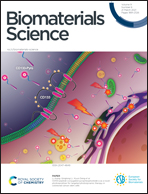Polymeric micelles using cholinium-based ionic liquids for the encapsulation and release of hydrophobic drug molecules†
Abstract
We generated stable amphiphilic copolymer-based polymeric micelles (PMs) with temperature-responsive properties utilizing Pluronic® L35 and a variety of ionic liquids (ILs) to generate different aqueous two-phase micellar systems (ATPMSs). The partitioning of the hydrophobic model compound curcumin (CCM) into the PM-rich phase and the drug delivery capabilities of the PMs were investigated. ATPMSs formed using more hydrophobic ILs (i.e., [Ch][Hex] ≈ [Ch][But] > [Ch][Pro] > [Ch][Ac] ≈ [Ch]Cl) were the most effective in partitioning (KCCM) and recovering (RECRich) CCM into the PM-rich phase (15.2 < KCCM < 22.0 and 90% < RECRich < 95%, respectively). Moreover, using 1.2 M [Ch][But] and 0.2 M [Ch][Hex] ILs yielded higher encapsulation efficiency (EE) (94.1 and 96.0%, respectively) and drug loading (DL) capacity (14.8 and 16.2%, respectively), together with an increase in the average hydrodynamic diameter of the PMs (DH) (42.5 and 45.6 nm, respectively). The CCM–PM formulations were stable at 4.0, 25.0, and 37.0 °C and the release of CCM was faster with the less hydrophobic ILs (i.e., [Ch]Cl and [Ch][Ac]). Furthermore, due to the lower critical solution temperature properties of Pluronic® L35, the PMs exhibit temperature responsiveness at 37.0 °C. In vitro cytotoxicity assays were also performed to determine the potency of CCM–PM formulations, and a 1.8-fold decrease in IC50 values was observed between the CCM–PMs/[Ch][Hex] and CCM–PMs/[Ch]Cl formulations for PC3 cells. The lower IC50 value for the [Ch][Hex] version corresponded to a greater potency compared to the [Ch]Cl version, since a lower concentration of CCM was required to achieve the same therapeutic effect. The ATPMSs investigated in this study serve as a novel platform for Pluronic® L35/PBS buffer (pH 7.4) + IL-based ATPMS development. The unique properties reported here may be useful in applications such as controlled-release drug delivery systems (DDS), encapsulation, and bioseparations.



 Please wait while we load your content...
Please wait while we load your content...